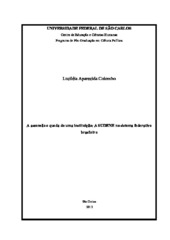| dc.contributor.author | Colombo, Luciléia Aparecida | |
| dc.date.accessioned | 2016-06-02T19:14:25Z | |
| dc.date.available | 2013-02-15 | |
| dc.date.available | 2016-06-02T19:14:25Z | |
| dc.date.issued | 2012-12-19 | |
| dc.identifier.citation | COLOMBO, Luciléia Aparecida. A ascensão e queda de uma instituição: a SUDENE no sistema federativo brasileiro. 2012. 333 f. Tese (Doutorado em Ciências Humanas) - Universidade Federal de São Carlos, São Carlos, 2012. | por |
| dc.identifier.uri | https://repositorio.ufscar.br/handle/ufscar/955 | |
| dc.description.abstract | The thesis statement main purpose is to map the institutional trajectory of SUDENE, from the time when it was created in 1959 by President Kubitschek, up to its dissolution in 2001 by President Fernando Henrique Cardoso. The theory that supported this study is the Brazilian federalism, asymmetrical, from the standpoint of the economic level of their regions. According to SUDENE`s trajectory, the central hypothesis of the research is that institutional changes processed over time contributed to its disintegration and its subsequent elimination. The secondary objective is to provide an overview of the institutional evolution of Superintendent, highlighting the motivations, strategies and conflicts involved in their changes. As a result, it is possible to emphasize that the changes processed during the military regime in 1964 were decisive for the gradual withdrawal of the institutional power. Moreover, with the democratization of the country, the Constitution of 1988 promoted the recovery of federal entities such as states and municipalities, which started to establish unilateral regional development policies, which did not require the mediation of SUDENE. The increase of the transfers of the federal unities, foreseen in the Letter of 1988, it was also decisive for the changing pattern of intervention performed, in which the Federal Government limited to compliance with these constitutional provisions. Thus, the institution lost space as an arena for the articulation of the Northeast regional interests, it was a decisive factor in their it extinction disappearance. | eng |
| dc.description.sponsorship | Universidade Federal de Minas Gerais | |
| dc.format | application/pdf | por |
| dc.language | por | por |
| dc.publisher | Universidade Federal de São Carlos | por |
| dc.rights | Acesso Aberto | por |
| dc.subject | Ciência política | por |
| dc.subject | SUDENE | por |
| dc.subject | Federalismo | por |
| dc.subject | Desenvolvimento regional | por |
| dc.subject | Brasil, Nordeste | por |
| dc.subject | Mudança institucional | por |
| dc.subject | SUDENE | eng |
| dc.subject | Federalism | eng |
| dc.subject | Regional Development | eng |
| dc.subject | Northeast | eng |
| dc.subject | Institutional Change | eng |
| dc.title | A ascensão e queda de uma instituição: a SUDENE no sistema federativo brasileiro | por |
| dc.type | Tese | por |
| dc.contributor.advisor1 | Noronha, Eduardo Garuti | |
| dc.contributor.advisor1Lattes | http://lattes.cnpq.br/6908348693613769 | por |
| dc.description.resumo | O objetivo central da tese é traçar a trajetória institucional da SUDENE, desde sua criação, em 1959, pelo Presidente Juscelino Kubitscheck, até sua extinção, em 2001, pelo Presidente Fernando Henrique Cardoso. Utilizamos como pano de fundo o federalismo brasileiro, assimétrico, do ponto de vista do nível econômico de suas regiões. A hipótese central da pesquisa, testada em relação à SUDENE, é que as mudanças institucionais processadas ao longo do tempo contribuíram para seu esfacelamento e conseqüente extinção. O objetivo secundário da tese é constituir um quadro geral da evolução institucional da Superintendência destacando motivações, estratégias e conflitos envolvidos nesta mudança. Ressaltamos que as mudanças processadas durante o Regime Militar, em 1964, foram decisivas para a retirada gradual de poder da instituição. Além disso, a redemocratização do país, com a Constituição de 1988, promoveu a valorização de entes federados, como os estados e municípios, os quais passaram a estabelecer políticas de desenvolvimento regional de maneira unilateral, que não necessitavam mais da intermediação da SUDENE. O aumento das transferências federais, previstas na Carta de 1988, também foi decisivo para a mudança de padrão de intervenção realizado, a partir do qual o Governo Federal se limitou ao cumprimento destes dispositivos constitucionais. Desta forma, a instituição perdeu espaço enquanto uma arena de articulação dos interesses regionais nordestinos, fator decisivo para sua extinção. | por |
| dc.publisher.country | BR | por |
| dc.publisher.initials | UFSCar | por |
| dc.publisher.program | Programa de Pós-Graduação em Ciência Política - PPGPol | por |
| dc.subject.cnpq | CIENCIAS HUMANAS::CIENCIA POLITICA | por |
| dc.contributor.authorlattes | http://lattes.cnpq.br/9421549755358841 | por |
